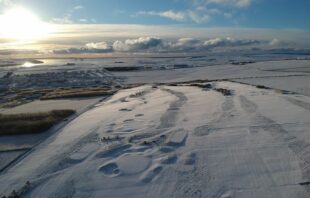Winter has been a washout. If it wasn’t the onslaught of the Beast from the East, it was the never-ending spells of rain that kept the fairways and greens sodden and the cash tills closed.
Gene Kelly might have been singing in the rain but relentless downpours are no laughing matter for the golf industry. What is causing these extremes in weather? Can it simply be put down to climate change? Of course, we can’t control the weather but is there anything clubs can do to counter the storm?
Mark Hunt is technical director at Headland Amenity, who manufacture and supply turf management products to the sports turf industry. Since 2007, his weekly Weatherblog on meteorological patterns and how they can affect turf has become essential reading for course managers, greenkeepers and groundsmen. So who better to ask about why our climate seems so volatile?
There’s a lot of debate about climate change. But is there any doubt in your mind that the weather patterns are changing?
I actually think, contentiously, that the debate is irrelevant. My pet theory is that the nature of the jet stream has changed and that’s what is giving us different extremes of weather. People can argue that we may have experienced those extremes in the past but we can’t correlate that with the jet stream because we have only known about it since the early 1940s. We can’t go back in history.
So looking at why the weather has changed – whether it is climate change, caused by man’s activities, or whatever – it’s slightly irrelevant. The debate for us is how we deal with what we’ve been dealt. We are getting more extremes of weather and that’s leading to positives and negatives from a golf club manager’s point of view. The negatives, specifically, are disease activity. It’s far more aggressive and it’s active at different times of the year than it was when I started in the industry in 1989.
We are seeing diseases we saw maybe in November now in July and August. We are seeing diseases affecting grasses that we have never seen before. You only have to give the example of the run up to last Christmas. From the 22nd right through to Christmas Day, we had four days that were really conducive to disease. Most people are shutting up shop for the year, but some of our highest disease pressure was the week before Christmas. That was caused by a peak in the jet stream that allowed warm air to come up from the Med. We went to 8, 9, 10, 11 and 12 degrees at night with very high humidity.
The combination of the two drives disease. We are getting more of these peaks and more of these troughs – and that’s because of the behaviour of the jet stream. Whether it has fundamentally changed we can’t prove but it is undoubtedly what’s affecting our surfaces.
A lot of course managers say to me they think the seasons have altered…
Just about everywhere I go, one of the biggest changes is the autumn season. We’re getting warmer air later into the year. Even if last autumn was a traditionally cold one – we had snow in December – we also had 12, 13 and 14 degrees at night. Autumn has definitely changed. October is more or less an extension of September now and we don’t really start getting cool nights and frost (until) November.
It’s very rare we get them any earlier. In January, it was 13 degrees where I lived in the Midlands. If I’d dropped you there and asked you what month of the year it was – if you didn’t look at the trees – it could have been March. That’s not normal for us. People say ‘we had that 25 or 30 years ago’. ‘We had that in 1947’. ‘We had the worst winter’. I looked at the data and we were nowhere close to that. It’s difficult to say yes/no. We have to deal with those peaks and troughs. But the seasons have definitely changed. It’s almost like we have shunted up.
Whatever the debate, what we can all agree on is that the extremes of weather are much more than they used to be…
We have more moisture in the atmosphere now because we are warming up. Sometimes we have these trough events where a low pressure system gets stuck over us. Instead of moving across the UK and Ireland quickly, it gets stuck in situ and we get rain, and rain and rain – we get these very high daily rain totals.
So what do these pressures mean for golf courses and club managers in particular?
There’s a multitude. If you look at what we’ve just talked about – because we get very high levels of rainfall over a short period, you are asking the root zone of the green and elsewhere to drain really quickly. You are asking them to be able to shift water quickly to remain playable. You can do that on a green – if it is constructed the right way with proper drainage. Most golf courses away from the green don’t have really well drained fairways.
You are almost exceeding what you can expect the grass, or root zone, to move through. It’s not like you have a small amount of rainfall at a time, it’s a big dollop and you’ve got to move it through quickly. We often exceed the parameters of what the greenkeepers are maintaining. They are having to do more aeration, more sand, more top dressing, to move water through quicker.
Secondly, and arguably the most significant, is disease management. We are getting more significant climatic drivers and, at the same time, we are getting legislation that is removing a number of different types of pesticide so we have got a perfect storm. They have less armoury to control disease and have much more aggressive disease activity that comes really quickly.
Disease can move from affecting a plant to killing it in 48 hours because you will have 18 or 20 degrees in October. The disease is much more aggressive. In the old days, you could see a bit of disease and decide whether you wanted to treat it or not. A lot of people would just grow it out. Now, by the time you see it, and if the conditions are right, it will scar down to the crown. If you get that scarring in October, you might be left with that until March or April.
How much extra rain are we seeing these days than previously?
Figures are deceptive. If you look across a year, you might say ‘we don’t get any more rain than we used to’. It’s more the patterns of rainfall. So, even in a month, you could say ‘we had 70mm in July’. That’s kind of a wettish July. But when you drill down, you might find that 70mm, by and large, fell on four days. You get these big dollops, rather than spread generally.
That is because we have more moisture in the atmosphere and we are getting these trough events where we tend to get very high amounts over very short periods.
So it’s not necessarily that we get more rain across a year or a month, it’s the pattern of the rainfall. You have got to look further than general figures.
The warmer temperatures in autumn are affecting growing seasons as well – grass is growing for longer?
You could have fungicide on, and you’re still cutting three times a week in October. So you are removing that fungicide quicker. We did some tests – October 2017 versus October 2016 – and fungicide was lasting about seven days less. We lost a week. Instead of it lasting three weeks, we were only getting a fortnight out of it. That means two applications and a doubling of the cost. They are not cheap things.
That’s where managers will see some of the real impact. Not just in the disease but in the costs of having to treat it…
If you have 30 per cent more growth in October that means you are going to have to cut and maintain that growth.
That’s more diesel, more man hours and more machinery hours. It’s not all bad news. In the third week of January, it was mild. I had a lot of people who did a lot of aeration, at a time of year when most golfers are just happy to get out and hit a ball around.
We didn’t have the Augusta effect. They were taking advantage of a weather window, because they got growth that week and, providing they could get out and do it and their ground conditions allowed it, they could do some aeration and get recovery before the main revenue months started in March, April and onwards. You could do the work then instead of in March.
It will be easier then, usually, to get courses ready for that traditional opening, because the growing season starts earlier?
In general it does. Just to flip it on a bit, there’s also a pattern that Aprils are becoming very difficult from a grass growth point of view. In general, they are drier and cooler and so we have a warm day but a frost at night. A golfer plays at midday and he’s in shirt-sleeves. But the greenkeeper, when he was cutting the greens in the morning, probably got frost on the machine. In those conditions, grass just doesn’t want to grow. March and April would be your traditional aeration dates. If you leave it until the end of March, you are not going to get much recovery in April. You probably don’t get recovery until May and June.
They say you can’t control the weather. Is there anything clubs can do?
We can’t control the weather but we can be a lot more proactive with understanding the weather and using it for our benefit, understanding when it is going to work against us and planning. At seven days you are at the limit of accuracy (with weather forecasts). Beyond 10 days, the accuracy of a weather forecast, for me, is la-la land.
In the UK, with our climate and being on the line of the sub Polar system, it is just too variable. So what we can do is use the weather sometimes to our advantage, but also look ahead and say ‘I can see some high disease activity coming, I’m going to do x, y and z to pre-empt it’ rather than ‘oh dear, I have got a lot of disease, what am I going to do?’ The good guys, and a lot of the younger guys, are beginning to change their management to be more proactive rather than reactive.


